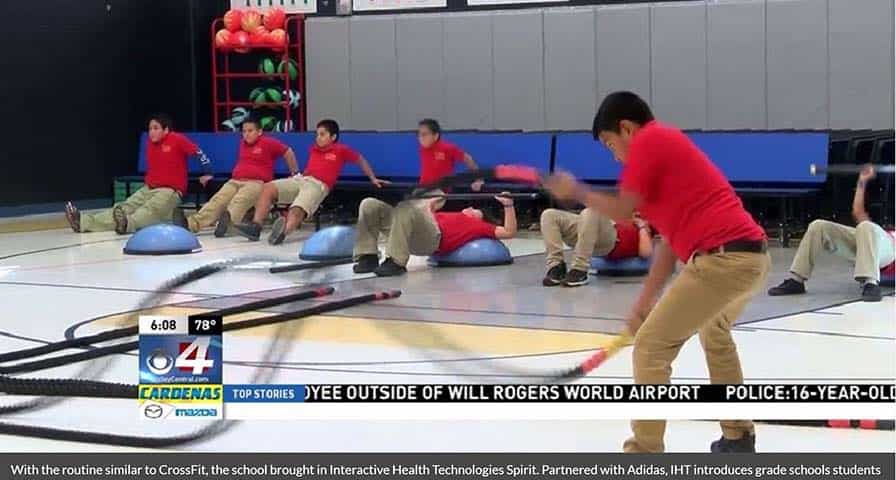May 23, 2017 – IHT congratulates IDEA Public Schools on attaining high academic achievement while maintaining a commitment to deliver physical education programs that motivate students to improve their health and academic performance.
 On May 5, the Washington Post released its 19th annual list of America’s Most Challenging High Schools. IDEA, a system of public charter schools operating throughout Texas, saw five of its campuses rank among the nation’s top nine most academically challenging schools. The Post ranks schools based on the number of Advanced Placement, International Baccalaureate and Cambridge tests taken by students and number of graduating seniors in the measured school year.
On May 5, the Washington Post released its 19th annual list of America’s Most Challenging High Schools. IDEA, a system of public charter schools operating throughout Texas, saw five of its campuses rank among the nation’s top nine most academically challenging schools. The Post ranks schools based on the number of Advanced Placement, International Baccalaureate and Cambridge tests taken by students and number of graduating seniors in the measured school year.
Frontier College Prep (third), Mission College Prep (fourth), San Juan College Prep (fifth), San Benito College Prep (sixth) and Quest College Prep (ninth) earned high marks for their challenging curriculum. At four of the IDEA campuses, at least 76 percent of the students passed at least one of the AP tests, and both Frontier and San Juan boasted 89 percent passing rates. IDEA’s students found academic success while also participating in a physical education program in they combined to burn 25 million calories while logging 3 million minutes of moderate to vigorous physical activity.
“The IDEA Public Schools network, with nearly 30,000 mostly low-income students in Texas, requires that each take 11 AP courses,” writes columnist Jay Matthews. “Parents applaud their children breaking out of the remedial courses, with homework increasing gradually so they can get used to the load.”
The Washington Post published its rankings shortly after U.S. News and World Reports included seven IDEA campuses on the annual list of America’s best high schools. Four of the campuses – Quest, Frontier, Mission and San Juan — received gold medal awards. Each ranked in the top 140 on the list of 500 schools.
Committing to PE
 The lofty rankings come in a year in which IDEA has implemented new technology to bolster its physical education efforts. IDEA spent the year implementing the IHT Spirit System® at each of its campuses to track student performance during physical education classes throughout the day.
The lofty rankings come in a year in which IDEA has implemented new technology to bolster its physical education efforts. IDEA spent the year implementing the IHT Spirit System® at each of its campuses to track student performance during physical education classes throughout the day.
“When our leadership invested in IHT’s technology, that was the commitment that physical activity is a primary factor in how we’re going get our kids to be able to grow to success as they head into the real world,” said Eren Kirksey, IDEA’s PE Curriculum Manager.
Students wear the IHT ZONE wrist heart rate monitors during class and then receive workout summaries generated by Spirit Assessment Measures software. The software delivers heart rate reports to students and parents and allows teachers to compile data to show progress toward individual fitness goals as well as state and national fitness standards.
Across all of IDEA’s campuses, the data generated by students daily use of the Zone monitors is staggering. Overall, IDEA students:
- Spent more than 3 million minutes engaged in moderate to vigorous physical activity
- Burned more than 25 million calories
At the five schools in the Washington Post’s rankings, students:
- Logged 53,500 minutes of MVPA
- Burned 405,000 calories
‘It’s amazing’
Kirksey manages the data and delivers PE progress reports to the teachers and to other administrators, who are taking the data to heart. Student response to wearing the Zones, a marked improvement in PE performance, has enabled a policy shift, namely at IDEA’s Monterrey Park campus.
“The principal [Curtis Lawrence] saw what was happening and changed up his entire dynamic,” Kirksey explained. “We used to pull kids from PE for academic interventions. The principal had a meeting with his staff and told them that these monitors are going to help kids get smarter in the classroom. The students will be earning the use of the monitors. ‘You will no longer take kids out of PE for academic intervention until they have had at least 30 minutes in PE utilizing the monitors.’
“We can see that the kids are focusing better when they come back into the classroom,” Kirksey continued. “It is amazing how this simple tool has bridged an entire district.”
Well-rounded student is more than an idea
The increased focus on PE hasn’t cost IDEA anything when it comes to its academic standards. If anything, Kirksey said, it means that IDEA is sending more well-rounded students to college.
“The end game of what we’re talking about is making the most academically sound kids, but there is a danger to not being able to work out,” Kirksey said. “As they get into college, we are starting to understand that not being able to work out, be recreationally active … plays a real big factor in how successful they are going to be.”
With a growing number of studies linking overall fitness with improved academic readiness, we are thrilled that IDEA has been able to utilize our technology to put students in the right frame to succeed, not just in a rigorous academic environment but also in learning skills to keep them healthy and active after they graduate from high school.


